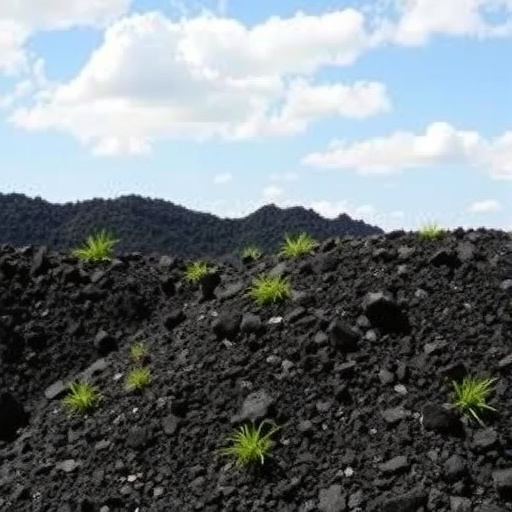In an era marked by the urgent need to understand anthropogenic impacts on our environment, recent scientific inquiry into soil contamination reveals an intricate narrative woven by coal combustion activities. A groundbreaking study conducted in the Most Basin, Czech Republic, provides critical insights into how coal-fired power generation deposits hazardous elements into surrounding soils, calling for a comprehensive empirical approach to effectively identify and mitigate these impacts. This nuanced investigation emphasizes the importance of holistic methodologies in unravelling the complexities of environmental contamination linked to energy production.
Coal combustion remains a dominant energy source in many parts of the world, despite growing concerns about its environmental footprint. The combustion process releases a multitude of risk elements, including heavy metals such as arsenic, lead, cadmium, and mercury, which can accumulate in soil matrices, posing long-term hazards to ecosystems and human health. The study at hand meticulously dissects these contributions, focusing on the Most Basin—a historically significant coal mining and power generation hub that serves as a microcosm for understanding such environmental dynamics on a global scale.
What distinguishes this study is its empirical holistic approach, which transcends simple elemental concentration analysis. Instead, it integrates geochemical, mineralogical, and spatial distribution data to form a comprehensive understanding of contaminant behavior and origin. This multi-faceted methodology is crucial for distinguishing between natural background levels of risk elements and those elevated by anthropogenic coal combustion residues, a challenge that has confounded environmental scientists and policymakers alike.
Using advanced geochemical fingerprinting techniques, the researchers were able to generate detailed isotopic and elemental profiles of soil samples collected across varying proximities to coal combustion installations. These profiles revealed distinct signatures attributable to airborne particulate matter emitted during coal burning, setting them apart from regional geogenic sources. In particular, the enrichment patterns of loosely bound or bioavailable fractions of critical risk elements shed light on their mobility and potential ecological impacts.
Beyond identification, the study addresses the spatial heterogeneity of contamination. The distribution maps demonstrate how prevailing wind patterns, topography, and deposition mechanisms lead to variable contamination hotspots across the basin. Such spatial delineation is invaluable for targeted remediation strategies, enabling environmental managers to prioritize high-risk zones and optimize resource allocation for soil rehabilitation efforts.
Moreover, the research delves into the temporal dimension by comparing soil contamination levels with historical data, underscoring trends corresponding with fluctuating coal combustion intensity over the decades. This temporal perspective provides a dynamic view of contamination progression, revealing both legacy pollution and recent emissions, thereby informing forecasts of future environmental quality if current energy practices persist.
A particularly innovative aspect of this study is its focus on synergistic contamination effects. Coal combustion does not release risk elements in isolation; rather, complex interactions among multiple pollutants influence their chemical speciation, mobility, and bioavailability. The holistic framework incorporates analytical methods capable of detecting these interactions, such as sequential chemical extractions and speciation modeling, deepening the understanding of contaminant dynamics under field conditions.
From a toxicological perspective, insights generated here have profound implications. Soils contaminated with elevated levels of risk elements can facilitate their entry into the food chain through plant uptake or leaching into groundwater systems. By identifying specific elements and their bioavailable forms, the study aids in assessing ecological risk and human exposure potential, guiding public health interventions and land use policies.
The implications extend beyond the immediate study region, providing a template for comparable settings globally. Many industrial areas grappling with legacy coal combustion pollution will benefit from adopting this empirical holistic approach, ensuring accurate contamination assessments that prevent either underestimation of risks or unnecessarily conservative restrictions.
Integral to the success of this research is the rigorous sampling strategy employed. The team collected over a hundred soil samples across diverse land covers, elevations, and distances from combustion sources. This extensive dataset, combined with robust statistical analyses, lends high confidence to the study’s conclusions and advances the reliability of contamination assessments in complex environments.
Additionally, the incorporation of remote sensing and GIS tools enhanced the spatial analysis, enabling the visualization of contamination footprints with precision and aiding communication with stakeholders. These modern technological applications exemplify how interdisciplinary integration accelerates environmental research efficacy and applicability.
In conclusion, the Most Basin study articulates a compelling narrative: accurate identification of coal combustion’s impacts on soil contamination demands a comprehensive, data-rich, and holistic strategy. This paradigm ensures that remediation efforts are grounded in a true understanding of contaminant sources, behaviors, and ecological risks. In doing so, it contributes substantially to the sustainable management of post-industrial landscapes, protecting both environmental integrity and public health.
As the world grapples with energy transitions, studies like this serve as critical reminders of coal’s enduring legacy in the environment and the sophisticated scientific efforts required to address it. The empirical holistic approach showcased here stands as a beacon for future research and policy, ensuring that contaminated landscapes can be rehabilitated with precision and foresight.
Subject of Research: Identification of coal combustion impacts on soil contamination by risk elements in the Most Basin, Czech Republic.
Article Title: Identification of coal combustion impacts on soil contamination by risk elements needs empirical holistic approach: case study in the Most Basin, Czech Republic.
Article References:
Grygar, T.M., Adamec, S., Tůmová, Š. et al. Identification of coal combustion impacts on soil contamination by risk elements needs empirical holistic approach: case study in the Most Basin, Czech Republic. Environ Earth Sci 84, 446 (2025). https://doi.org/10.1007/s12665-025-12458-z
Image Credits: AI Generated




